
The alchemical scrolls which are associated with George Ripley are unusual manuscripts which illustrate the pursuit of the Philosophers' Stone.
Ripley was a canon of Bridlington in Yorkshire who lived from about 1415 to 1495. He was renowned as an alchemist and author of alchemical works in rhyme, and his verses are used on most of the scrolls. Alchemical scrolls are rare and there are only 16 in the UK; in London there are seven in the British Library, and two in the Wellcome Library; the Bodleian Library in Oxford has five, and the Fitzwilliam Museum in Cambridge has one, the longest at 21 feet. There are also four scrolls in the United States of America ( Yale University; Princeton University; Huntington Library, San Marino;and the Getty Center for the History of Art and the Humanities, Santa Monica) all of which were bought at sales in London.
The provenance of Ripley scrolls is obscure in many cases but they usually belonged to aristocratic and wealthy individuals. When and where they were produced is uncertain although it is thought that some of them originated in Lübeck in the 16th century. The Edinburgh scroll is traceable back to the 1640s at the latest. Where it came from before this is intriguing. Its owner Sir George Erskine of Innertiel (now Inverteil) near Kirkcaldy who was born in about 1570 and died in 1646), had contacts with other aristocrats in Scotland and London who studied alchemical manuscripts. He was also in touch with Rosicrucians in Hesse, Germany, but it is unlikely that they brought the scroll to Erskine.
The Ripley Scroll
The scroll forms an appropriate and relevant part of the alchemical manuscripts which had belonged to Erskine and were presented by his grandson the Earl of Cromartie to the College in 1707. George Mackenzie (1630-1714), first Earl of Cromartie, had been involved in 1685 as Viscount Tarbat in an official capacity in the ratification of the 1681 charter of the College. He was on very friendly terms with founding members of the College including Balfour, Sibbald, Pitcairne and Stevenson, all like him with a Fife background. While it is likely that Cromartie was made a Fellow of the College his name is not amongst those Fellows or honorary Fellows of the period who are listed from 1681 in the Charter and Regulations (1789). However the records almost immediately after the College was established, for the period December 1682 to 1694 are missing and it is likely that he was made a Fellow during that time. The scroll was shown to the Scottish Society of Antiquaries in 1827 by Dr William Moncrieff the College Librarian, and the first account of it, published in 1876, is based on Moncrieff's detailed description. The scroll contains a series of pictures which purport to illustrate the steps necessary for the acquisition of the Philosophers' Stone with text in Latin phrases, and alchemical poems by George Ripley. The sequence of emblems is a version of the pattern most often found in these scrolls and consists of a series of figures which are well and skilfully drawn.

The scroll is about 18 feet 4 inches(5.5m) long and about 23 inches (57.5cms) wide. It consists of seven large sheets of vellum each about 32 inches(80cms) long except for the last section which is 9 inches(22.5cms) long. They are attached to a linen backing and there is a roller at the top and a wooden bar at the bottom. The top shows evidence of wear, and perhaps damp at some time, so that the images are rather faint. It was copied for Moncrieff and Small's paper by a photolithographic process, much used from the early 1860s on, which gives a very clear illustration of the drawings. The text is impossible to read from this but all of it is in Moncrieff's account. Hand written at the top is: Edinburgh 19t Die Junii 1707. Hoc mysticum symbole, in avita Bibliotheca Doni Georgii Areskine, Equitis aurati, supremi senatus et colidgii Justicii in Scotia Senator inter primos Justitia et eruditione clarus philosophij Hermeticae et aluminus et decor, Regumque sui aevi a conciliis secretis almo et spectabile Collegio Medicorum Edinbur Regali DD. Geo Cromartio.

Although the series of images is a continuum and each leads into the next it can be divided arbitrarily for descriptive purposes into sections.
The Ripley Scroll begins with a large bearded figure clutching an egg-shaped vase. The figure, in cap/headdress and robe, is almost certainly that of Hermes Trismegistus (thrice-greatest) the legendary founder of alchemy who is identified with the Egyptian god of healing Thoth.
The appearance is consistent with other portraits of him over the time at which the scrolls were originally produced: for example, Stefano's mosaic on the floor of Siena Cathedral (1488). The vessel which he holds is an Hermetic Vase (Vase of the Philosophers; Philosopher's Egg). The egg shape was highly significant and was symbolic of creation and in it the Great Work of making the Philosopher's Stone was carried out. Needless to say the vessel is hermetically sealed by a stopper.
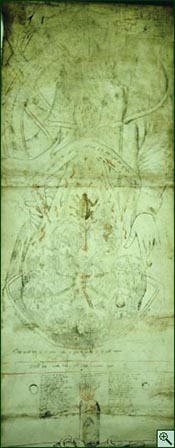
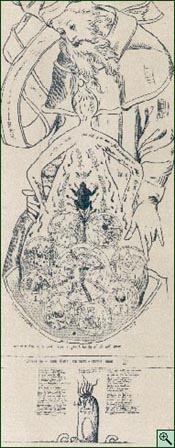
The vase contains a series of eight roundels linked by chains to a larger central roundel. Each small roundel has an hermetic vase containing one or two homunculi, male or female, flanked by monk-like figures. The larger central roundel has two seated figures holding a book; one of the figures appears to be Hermes again. In the top of the vase is a toad, and below it there are the words 'The black sea, the black lune, the black soll'; below this between two sets of verses is a furnace.
The furnace is set on leaves at the top of a tree below which a curious female figure with a dragon's tail and webbed feet but a human trunk (a Melusine) and with her head set between sun and moon, hangs downwards clutching a male child.
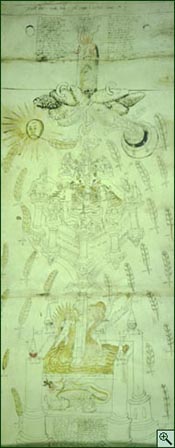
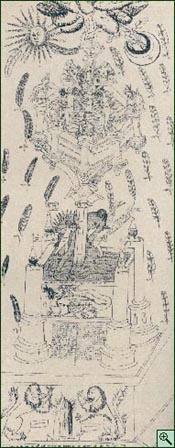
Below is a vine with grapes emerging from a seven sided pool or cistern bounded by seven pillars on each of which stands a monkish figure clutching an hermetic vase. In the pool stand naked male and female figures. The whole rests on an angular pillar which itself is set in a second four sided pool. Embracing the pillar is a large male figure like Samson, with one foot in the water having on his left a winged angel, and on his right another human figure with an indeterminate spiky structure behind it.
The front of the pool is decorated with a winged dragon spewing a toad from its mouth. A number of lines of verse come below this. These are in Ashmole's Theatrum Chemicum Britannicum, 1652 where they are attributed to Ripley. At each of the four corners of the structure is a pillar with an hermetic vase.
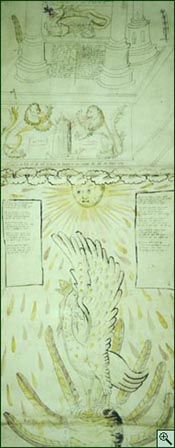
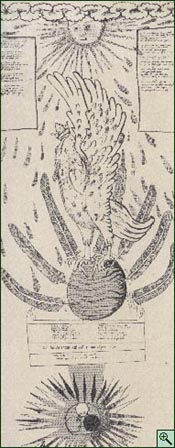
Each side of this section of the scroll is decorated with feathers. The pool rests on a base at the front of which are a red lion (left), and a green lion (right), on either side of a furnace with the words 'The mounthe of Cholerick beware'.
A large sun with eyes and mouth follows, then the striking figure of the crowned Bird of Hermes biting its left wing and standing on an orb into which seven feathers are stuck.
More feather-like objects are apparently falling from the sun's rays. Some more verses are set below the orb, after which there is another orb of a different kind containing linked white black and green balls within it, and with rays emanating from it.
This orb is set in a lunar structure below which is a dragon whose wings do not seem to be attached to its body but to the orb on which it stands. The dragon is bleeding from its belly, the drops flowing into the orb which has three black balls in it. Three paragraphs of poetry follow.
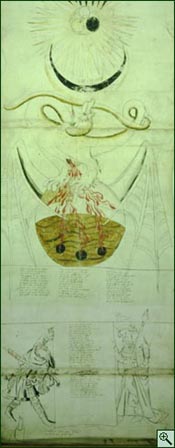
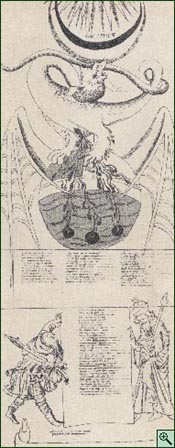
Finally two figures grasp either side of a column of poetry. The figure on the left is either a pilgrim or perhaps a philosopher (Ripley himself ?) carrying a curious staff which at its lower end is a shod hoof and has its upper end clothed in a scroll.
On the right is a figure in ecclesiastical robes with a crown and long staff, possibly Hermes again. Interspersed throughout the scroll are phrases in English and Latin, some of the latter in abbreviated form.
While the scrolls embody many conventional alchemical symbols the interpretation of these is obscure and a matter for conjecture. Amongst others the psychiatrist Jung has offered explanations of some of the imagery. As in much alchemical writing and imagery there is an evident Christian symbolism throughout. Some of the symbols are familiar alchemical ones: hermetic vases, a toad, the dragon, the Bird of Hermes and the red and green lions. But what they represent is another matter and can differ from one use to another. The toad often signifies earthly matter, or sophic sulphur in which the grosser physical properties of sulphur are absent. The Bird of Hermes which is shown as eating its wing has been interpreted as a stabilising act in relation to mercury. However, mercury does not always represent the familiar quicksilver but is rather a clue to properties more spiritual than chemical. The red lion may represent sulphur; the green lion mercury, or vitriol, or perhaps antimony. The bleeding dragon is probably a symbolic pelican 'vulning' itself, which is a common motif often with religious significance. There is so much detail in the scrolls' imagery that there is still a long way to go in explaining what lies behind it.
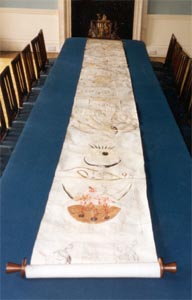
No comments:
Post a Comment
The power is in knowing that you are the center of the universe